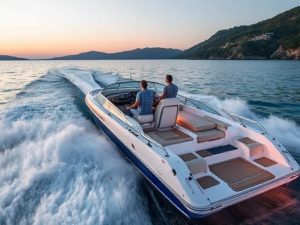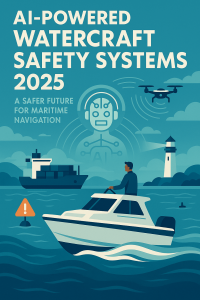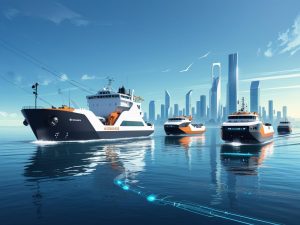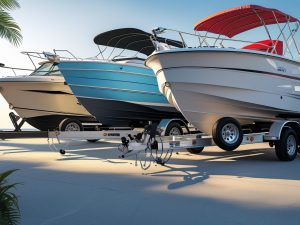As the world steadily transitions to more sustainable forms of transportation, the marine industry is experiencing a significant technological shift. Electric boats and watercraft are no longer niche experiments or limited to small recreational crafts. In 2025, we are seeing a full-fledged revolution where electric propulsion, smart systems, and eco-conscious designs are leading the charge.
This article delves into the top electric boat and watercraft trends in 2025, covering innovation in design, battery technology, market adoption, government regulations, and how this growing sector is shaping the future of water-based mobility.
1. The Rise of Fully Electric Vessels
One of the most defining trends of 2025 is the surge in fully electric boats, from leisure crafts to ferries and even commercial workboats. Unlike hybrid models, fully electric boats produce zero emissions, making them ideal for environmentally sensitive areas and urban waterways.
Popular Segments for Fully Electric Boats:
-
Personal recreational boats
-
Luxury yachts
-
Tourist vessels
-
Electric ferries and water taxis
-
Fishing and utility boats
Companies like Candela, X Shore, Vision Marine, and Silent Yachts are pushing boundaries with electric propulsion, delivering performance comparable to fossil-fuel-powered models.
2. Battery Innovation and Extended Range
Battery technology is the linchpin of the electric boat revolution. In 2025, lithium-ion and solid-state battery innovations have significantly improved energy density, safety, and charging times.
Advancements in 2025:
-
Solid-state batteries reduce fire risk and enhance efficiency.
-
Modular battery systems for easy upgrades and replacements.
-
Rapid-charging technologies offering 80% charge in under 30 minutes.
-
Energy recovery systems during deceleration and docking.
These innovations have enabled electric boats to travel up to 100 nautical miles or more on a single charge, depending on size and speed.
3. Integration of Solar and Renewable Energy Sources
Solar integration is no longer an experimental feature but a standard design consideration in electric watercraft. Boats are increasingly outfitted with flexible solar panels, smart energy management systems, and auxiliary wind-powered systems to support energy sustainability.
Use Cases:
-
Solar-powered catamarans like Silent Yachts can operate indefinitely under sunny conditions.
-
Off-grid cruising becomes more accessible with energy autonomy.
-
Ideal for eco-tourism and environmentally protected zones where combustion engines are restricted.
4. Smart Boat Technology and Autonomous Navigation
The electric revolution is closely tied to smart technology integration. In 2025, electric boats are equipped with IoT sensors, GPS-based automation, and AI-driven systems for performance monitoring and autonomous operation.
Features Leading the Trend:
-
Self-docking capabilities
-
Predictive maintenance via onboard AI
-
Smartphone-based remote control
-
Real-time energy usage dashboards
-
Wireless OTA (Over-the-Air) updates
Companies like Torqeedo and Navier are pioneering intelligent control systems that enhance safety, convenience, and energy efficiency.
5. Electrification of Commercial Marine Operations
Commercial operations are embracing electrification at scale. Ports, marinas, and logistics providers are investing in electric workboats, ferries, and cargo vessels to meet emission targets and reduce fuel costs.
Key Benefits:
-
Reduced operational costs through lower fuel and maintenance expenses.
-
Noise reduction, crucial for operations in urban harbors or nature reserves.
-
Compliance with tightening regulations in the EU, US, and Asia.
Government incentives and carbon emission penalties are pushing commercial marine stakeholders to invest in zero-emission fleets.
6. High-Performance Electric Sports Boats
In 2025, electric boats are no longer synonymous with slow, serene cruising. A new generation of high-performance electric sports boats is emerging, offering thrilling speeds, sharp handling, and quick acceleration.
Performance Highlights:
-
Top speeds exceeding 50 knots
-
Jet propulsion and hydrofoil options
-
Customizable performance profiles
Manufacturers like Vision Marine Technologies and Arc Boats are targeting adrenaline-seeking boaters who want speed without emissions.
7. Urban Water Mobility and Electric Ferries
As cities seek cleaner transport alternatives, electric ferries and water taxis are becoming integral to urban mobility plans. In 2025, several global cities have launched or expanded electric ferry routes.
Urban Electrification Examples:
-
Stockholm and Amsterdam: Entire commuter ferry fleets are electrified.
-
San Francisco and New York: Investing in electric ferries for inner-city transport.
-
Bangkok and Ho Chi Minh City: Piloting electric river taxis to combat pollution.
This trend addresses traffic congestion, pollution, and noise in dense urban environments.
8. Regulatory Support and Green Initiatives
Governments and international bodies are playing a crucial role in accelerating electric watercraft adoption. In 2025, policies, tax credits, and emission zone regulations are shaping industry direction.
Notable Measures:
-
EU Green Deal mandates emission reductions in marine transport.
-
Norwegian Parliament bans fossil-fuel vessels in UNESCO fjords.
-
California Air Resources Board (CARB) incentivizes electric boat purchases.
Such policies are driving both consumer and commercial users toward electrification.
9. Growth in Rental and Sharing Services
Another noteworthy trend in 2025 is the rise of electric boat rental and sharing platforms. These services allow people to enjoy electric boating experiences without the high upfront cost of ownership.
Features of This Trend:
-
App-based bookings
-
Dockside charging stations
-
Subscription and hourly plans
-
Eco-conscious tourism partnerships
Companies like GetMyBoat, Boatsetter, and Eboats Rentals are expanding fleets with electric options, targeting both tourists and locals.
10. Affordable Entry-Level Models
In previous years, electric boats were considered luxury products. In 2025, prices are dropping thanks to:
-
Mass production
-
Government rebates
-
Smaller, modular boats
Brands are now offering affordable electric dinghies, kayaks, and day boats starting at around $10,000, bringing sustainable boating to the masses.
11. Electric Jet Skis and Personal Watercraft (PWC)
The PWC segment is also electrifying rapidly. Electric jet skis and water scooters are popular due to their compact size and need for quiet operation in noise-sensitive areas.
Benefits:
-
No fuel spills or emissions
-
Quiet operation on lakes or eco-resorts
-
Lower maintenance needs
Leading models like the Taiga Orca and Narke GT95 are paving the way for fun and eco-friendly water sports.
12. Sustainable Boat Building Materials
Environmental focus is not just on propulsion but also on construction materials. In 2025, boatbuilders are using:
-
Recycled plastics
-
Bio-resins
-
Bamboo and cork decking
-
Aluminum hulls for recyclability
These materials lower the boat’s life-cycle carbon footprint and appeal to environmentally conscious consumers.
13. Global Electric Boat Market Forecast for 2025
The electric boat market is projected to exceed $15 billion USD by the end of 2025, growing at a CAGR of over 12%. Key growth drivers include:
-
Technological advances
-
Strong demand in Europe and North America
-
Expansion in Asia-Pacific markets
Leading Markets:
-
Norway
-
Sweden
-
Germany
-
USA (California, Florida)
-
China and South Korea (emerging leaders)
14. Challenges Facing the Electric Boat Sector
Despite strong momentum, some challenges persist:
-
Limited charging infrastructure in marinas
-
High initial purchase costs
-
Battery disposal and recycling concerns
-
Regulatory inconsistencies between countries
These are being addressed with public-private investments, better global standards, and innovation in marine battery recycling.
Frequently Asked Questions (FAQs)
1. Are electric boats better than gas-powered boats?
Electric boats offer many benefits such as zero emissions, lower maintenance, and quiet operation. However, gas-powered boats still outperform in long-range and high-speed offshore applications.
2. How far can electric boats travel on a single charge?
In 2025, most electric boats can travel between 30 to 100 nautical miles depending on speed, battery capacity, and boat type.
3. How long does it take to charge an electric boat?
With fast-charging infrastructure, boats can reach 80% charge in 30–60 minutes. Full charges may take 2 to 8 hours, depending on the system.
4. What is the average cost of an electric boat in 2025?
Prices range from $10,000 for small crafts to over $1 million for luxury yachts. The average recreational electric boat costs around $30,000 to $70,000.
5. Can electric boats be used in saltwater?
Yes. Most modern electric boats are designed for both freshwater and saltwater use. Corrosion-resistant materials and proper maintenance are essential for longevity.
6. Are government subsidies available for electric boats?
Yes. Many countries offer tax incentives, grants, or rebates to encourage the adoption of electric boats in 2025.
7. What is the lifespan of an electric boat battery?
Typically, marine-grade lithium-ion batteries last 7–15 years, depending on usage, maintenance, and charging practices.
8. Are there electric options for jet skis or personal watercraft?
Absolutely. Several models, like the Taiga Orca, offer high-performance electric jet skis with speeds up to 65 mph and 2-hour runtime.
Conclusion
The electric watercraft industry is undergoing a transformative era in 2025. With advancements in technology, strong market demand, and increasing regulatory support, electric boats are becoming more accessible, efficient, and diverse in use. From luxury yachts to urban ferries and rental fleets, the electric wave is reshaping how we travel on water.
As we look to a future of sustainable marine mobility, now is the perfect time to invest, explore, or transition into the electric boating lifestyle.





